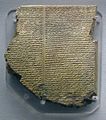Inanna facts for kids
Quick facts for kids Inanna/Ishtar |
|
|---|---|
|
|

Goddess Ishtar on an Akkadian Empire seal, 2350–2150 BC. She is equipped with weapons on her back, has a horned helmet, and is trampling a lion held on a leash.
|
|
| Abode | Heaven |
| Planet | Venus |
| Symbol | hook-shaped knot of reeds, eight-pointed star, lion, rosette, dove |
| Personal information | |
| Consort | Dumuzid the Shepherd and many unnamed others, Baal |
| Children | usually none, but sometimes Lulal and/or Shara |
| Parents | |
| Siblings |
|
| Equivalents | |
| Greek equivalent | Aphrodite, Athena |
| Roman equivalent | Venus, Minerva |
| Canaanite equivalent | Astoreth |
| Babylonian equivalent | Ishtar |
Inanna was a very important goddess in ancient Mesopotamia. She was known by different names, like Ishtar. People in Sumer, Akkad, Babylonia, and Assyria worshipped her. She was seen as the goddess of many things, including love, beauty, and even war. She was often called the "Queen of Heaven." The city of Uruk was a major place where people worshipped her. Her main symbols were the lion, the dove, and an eight-pointed star.
Contents
Who Was Inanna/Ishtar?
Inanna was the most popular goddess in ancient Sumer. Sumer was an old civilization in Mesopotamia. Later, other groups like the Akkadians, Babylonians, and Assyrians worshipped her. They called her Ishtar. She was seen as a powerful goddess. She represented love, beauty, and even desire. She also represented war and political power.
Her Important Symbols
Inanna and Ishtar had several special symbols. The lion showed her strength and power in battle. The dove represented love and peace. The eight-pointed star was also a key symbol for her. It often appeared in art and on seals. These symbols helped people recognize her.
Inanna's Family and Relationships
Inanna had different family stories depending on the region. In Uruk, people believed her father was An, the god of the sky. In other places, she was thought to be the daughter of Nanna or Enlil. She had an older sister named Ereshkigal. Ereshkigal was the queen of the Underworld. Inanna also had a twin brother, Utu-Shamash, who was the sun god.
Inanna was often linked with Dumuzid the Shepherd. Their story is about love and marriage. It was an important myth in Sumerian culture.
Stories About Inanna
Many ancient stories tell us about Inanna's adventures. One famous story is about her journey to the Underworld. She visited her sister Ereshkigal there. This myth shows her power and determination.
Another story is about her relationship with Gilgamesh. Gilgamesh was a legendary hero. In one part of his epic, Ishtar tries to win his attention. When he refuses, she sends a powerful creature, the Bull of Heaven, to attack his city.
Inanna's Influence on Other Cultures
Inanna and Ishtar were so important that their stories spread. Other ancient cultures had similar goddesses. For example, the Canaanites worshipped Astarte. The Greeks had Aphrodite and Athena. The Romans had Venus and Minerva. These goddesses shared many traits with Inanna and Ishtar.
Images for kids
-
Ancient Sumerian statuette of two gala priests, dating to c. 2450 BCE, found in the temple of Inanna at Mari
-
Ancient Akkadian cylinder seal depicting Inanna resting her foot on the back of a lion while Ninshubur stands in front of her paying obeisance, c. 2334 – c. 2154 BCE
-
The original Sumerian clay tablet of Inanna and Ebih, which is currently housed in the Oriental Institute at the University of Chicago
-
Ancient Mesopotamian terracotta relief showing Gilgamesh slaying the Bull of Heaven, sent by Ishtar in Tablet VI of the Epic of Gilgamesh after he spurns her amorous advances
-
Phoenician figure dating to the seventh century BCE representing a goddess, probably Astarte, called the "Lady of Galera" (National Archaeological Museum of Spain)
-
Altar from the Greek city of Taras in Magna Graecia, dating to c. 400 – c. 375 BCE, depicting Aphrodite and Adonis, whose myth is derived from the Mesopotamian myth of Inanna and Dumuzid
-
Illustration of Ishtar's Midnight Courtship from Leonidas Le Cenci Hamilton's 1884 book-length poem Ishtar and Izdubar, loosely based on George Smith's recent translation of the Epic of Gilgamesh
-
A modern illustration depicting Inanna-Ishtar's descent into the Underworld taken from Lewis Spence's Myths and Legends of Babylonia and Assyria (1916)
-
Babylonian terracotta relief of Ishtar from Eshnunna (early second millennium BCE)
-
Life-sized statue of a goddess, probably Ishtar, holding a vase from Mari, Syria (eighteenth century BC)
-
Hellenized bas-relief sculpture of Ishtar standing with her servant from Palmyra (third century CE)
Related pages
See also
 In Spanish: Inanna para niños
In Spanish: Inanna para niños



















